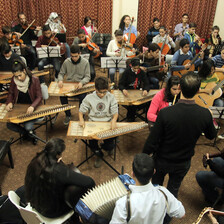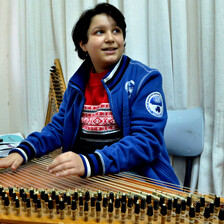The Electronic Intifada Gaza City 28 February 2012

Cello students practice at the Gaza Music School.
The Electronic IntifadaSarah, Abdelaziz and Anda have found a welcome distraction from Palestine’s troubles: music. They and 120 other girls and boys are enrolled in the Gaza Music School, a program of the A.M. Qattan Foundation launched in 2008.
Standing in front of a choir of dozens of children, 11-year-old Sarah sang an English-language song called “I have a dream.” Her guitar teacher, Ahmad Abu Amsha, and the school’s academic coordinator, veteran musician Ibrahim al-Najjar, watched with pride.
Tucked inside an area of just 320 squared meters, the school is located in the building of the Palestine Red Crescent Society in the Tel al-Hawa neighborhood of Gaza City. The school has since relaunched after it was destroyed during Israel’s three-week attack on the Gaza Strip in winter 2008-09, just days after its inaugural public performance.
Abdelaziz Abu Sharekh, an 11-year-old boy from the same neighborhood, played a traditional stringed instrument called a qanoun. One of the songs that he played was “The air breezed upon us,” made famous by the Lebanese living legend Fairouz.
Relieving stress
Abdelaziz told The Electronic Intifada that he has appreciated music since he was small.
“My father encouraged me to play music, telling me that he had hoped to learn or play music while he was a little child like me. Sometimes, when my father seems stressed out, I bring my qanoun and start playing for him, so that he calms down,” Abdelaziz said.
Twelve-year-old Anda Tamboura plays the cello. Her mother, who is of Romanian origin, teaches Anda music.
“The cello’s sound is very beautiful, so I chose the cello as my instrument,” Anda said.
Elsewhere in the school, other pupils were beating drums, tickling the ivories or blowing sweet notes from a flute. Inside one of the rooms, Ramzy Khatib, a Palestinian-American musician from Washington, DC, was teaching several children how to play a tune that fuses Eastern and Western music.
“I really feel happy being here at this place, since I am teaching children of Gaza music and the children of Gaza deserve life,” he said. “Music is an amazing means of expressing oneself.”
Eager to learn
Abu Amsha, the guitar teacher, participated in a choir that performed the Palestinian national anthem “My Homeland.”
“My homeland, my homeland, my homeland, both beauty and pride exist in thee,” are the first lines of the anthem. It was sung by more than forty girls and boys, accompanied by cello, lute, violin, guitar and qanoun.
Abu Amsha believes that music education in Gaza should be developed to include as many students as possible.
“During my work with the American School in northern Gaza, I noticed that there were many children in Gaza who wanted to learn music. When this music school was opened and I was appointed to teach at it, I encouraged some of my students at the American School to join the music school here,” Abu Amsha explained.
In April this year, the school will partner with the Edward Said National Conservatory of Music, named after the late Palestinian intellectual, in the West Bank city of Ramallah. Ibrahim al-Najjar, the school’s academic coordinator, said that he plans to offer courses lasting for eight years so that young musicians in Gaza can be better trained.
Hope to expand
According to al-Najjar, the 127 students here receive one-on-one attention from teachers. “Each student comes over to the school twice a week, forty minutes for each practical and theoretical class,” he explained. “That way, we do not have too much of a crowd, even though we do not have much space to absorb all students at once.”
Al-Najjar hopes that the school will be expanded in the future to reach even more children.
Editor’s note: the original version of this article gave the incorrect position of Ibrahim al-Najjar, as well as an incorrect location for the Edward Said National Conservatory of Music.
Rami Almeghari is a journalist and university lecturer based in the Gaza Strip.




